Financial System and Analysis: Accounting Records, Fraud, and Audit
VerifiedAdded on 2019/12/03
|13
|4128
|202
Report
AI Summary
This report provides a comprehensive analysis of financial systems, covering various aspects of accounting and auditing. It begins by defining financial systems and their importance, then delves into the purpose and use of different accounting records, including journals, ledgers, and bank statements. The report also assesses the meaning and importance of fundamental accounting concepts such as accrual, going concern, cost, and dual aspect. Furthermore, it evaluates factors influencing the structure of accounting systems and explores components of business risk, particularly those associated with strategic actions. The report analyzes control systems to identify fraudulent activities and discusses methods for detecting fraud. It also outlines the planning of an audit, including scope, materiality, and risk assessment, along with the use of audit tests and stages of the audit process. Finally, the report covers the preparation of draft audit reports and management letters.
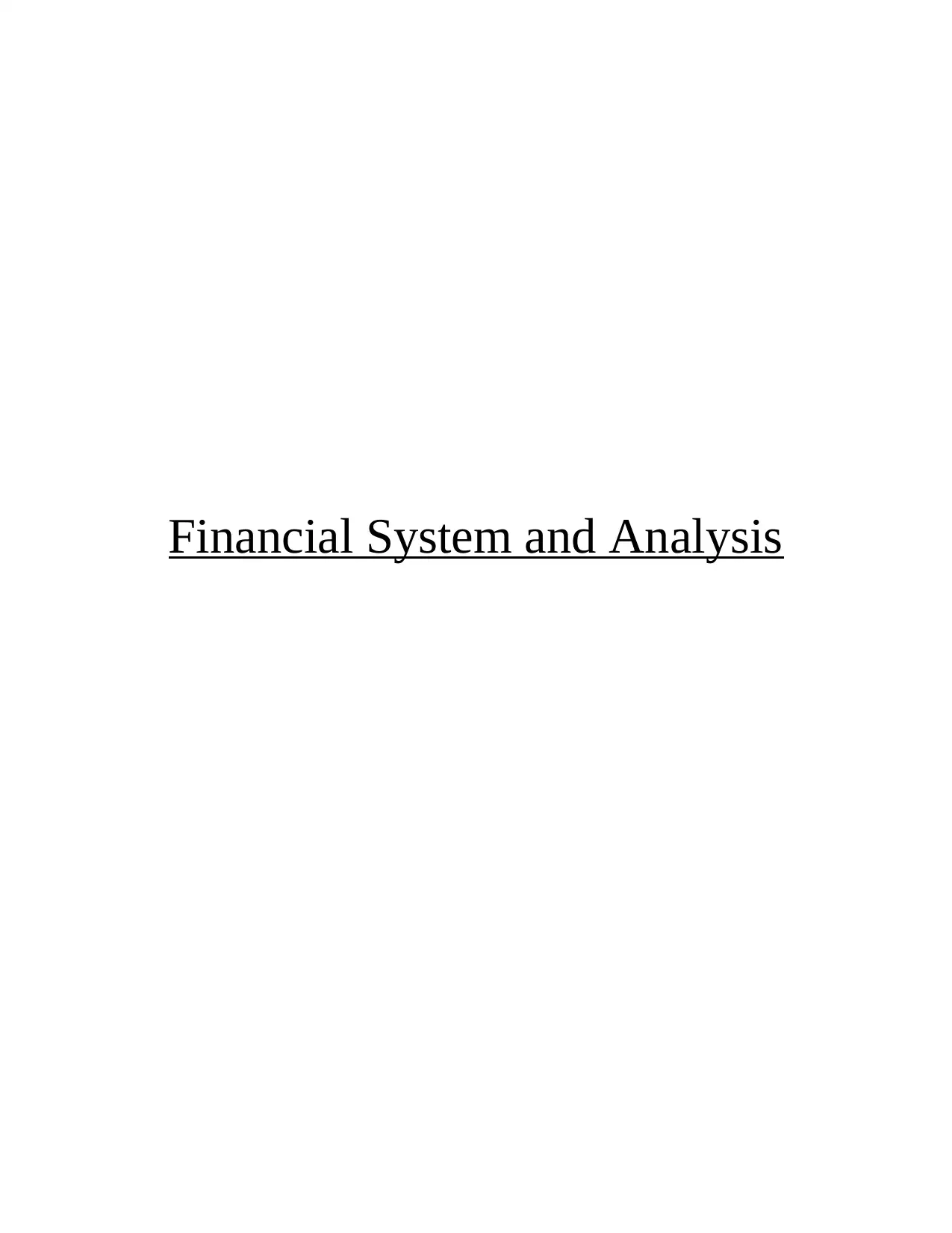
Financial System and Analysis
Paraphrase This Document
Need a fresh take? Get an instant paraphrase of this document with our AI Paraphraser
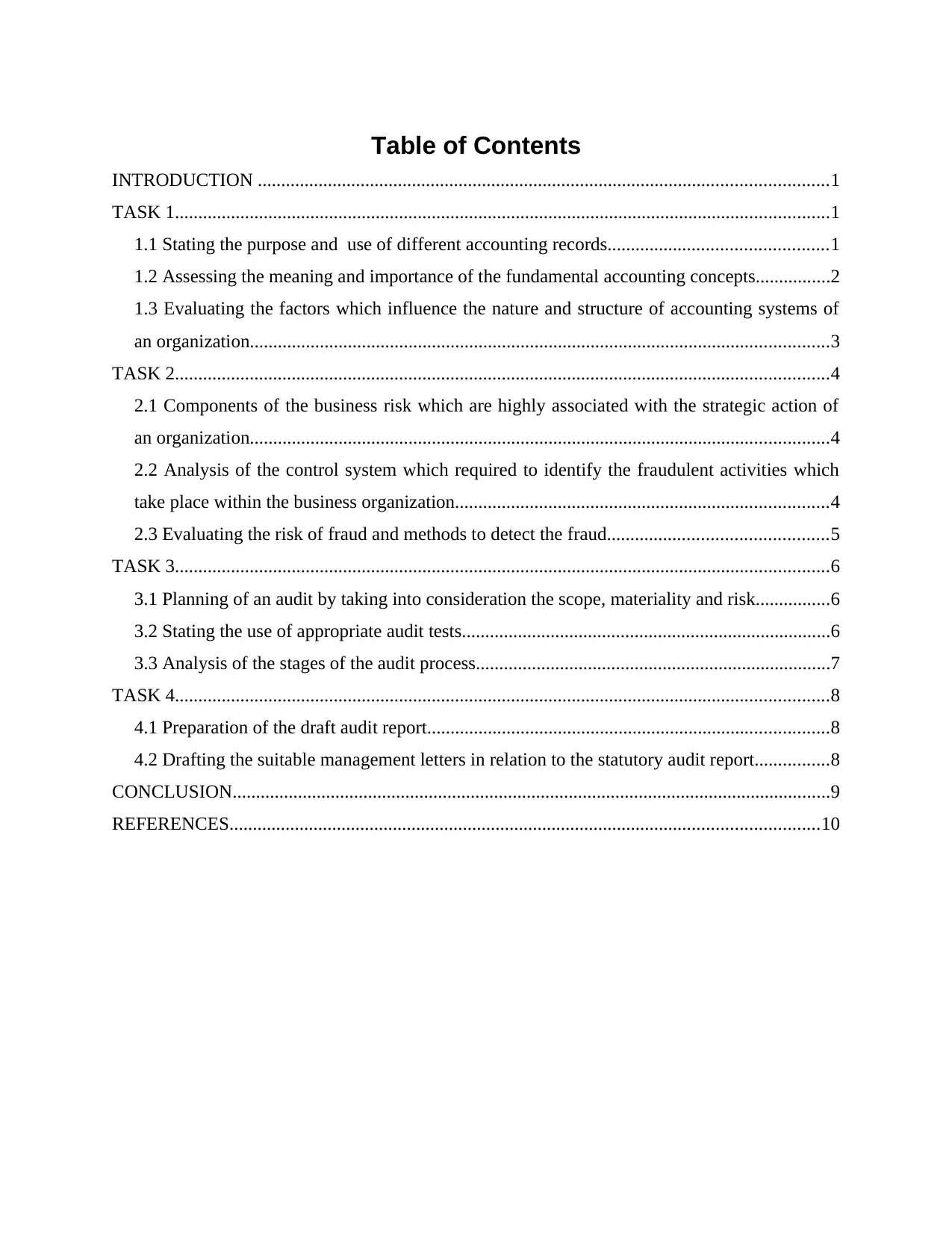
Table of Contents
INTRODUCTION ..........................................................................................................................1
TASK 1............................................................................................................................................1
1.1 Stating the purpose and use of different accounting records...............................................1
1.2 Assessing the meaning and importance of the fundamental accounting concepts................2
1.3 Evaluating the factors which influence the nature and structure of accounting systems of
an organization............................................................................................................................3
TASK 2............................................................................................................................................4
2.1 Components of the business risk which are highly associated with the strategic action of
an organization............................................................................................................................4
2.2 Analysis of the control system which required to identify the fraudulent activities which
take place within the business organization................................................................................4
2.3 Evaluating the risk of fraud and methods to detect the fraud...............................................5
TASK 3............................................................................................................................................6
3.1 Planning of an audit by taking into consideration the scope, materiality and risk................6
3.2 Stating the use of appropriate audit tests...............................................................................6
3.3 Analysis of the stages of the audit process............................................................................7
TASK 4............................................................................................................................................8
4.1 Preparation of the draft audit report......................................................................................8
4.2 Drafting the suitable management letters in relation to the statutory audit report................8
CONCLUSION................................................................................................................................9
REFERENCES..............................................................................................................................10
INTRODUCTION ..........................................................................................................................1
TASK 1............................................................................................................................................1
1.1 Stating the purpose and use of different accounting records...............................................1
1.2 Assessing the meaning and importance of the fundamental accounting concepts................2
1.3 Evaluating the factors which influence the nature and structure of accounting systems of
an organization............................................................................................................................3
TASK 2............................................................................................................................................4
2.1 Components of the business risk which are highly associated with the strategic action of
an organization............................................................................................................................4
2.2 Analysis of the control system which required to identify the fraudulent activities which
take place within the business organization................................................................................4
2.3 Evaluating the risk of fraud and methods to detect the fraud...............................................5
TASK 3............................................................................................................................................6
3.1 Planning of an audit by taking into consideration the scope, materiality and risk................6
3.2 Stating the use of appropriate audit tests...............................................................................6
3.3 Analysis of the stages of the audit process............................................................................7
TASK 4............................................................................................................................................8
4.1 Preparation of the draft audit report......................................................................................8
4.2 Drafting the suitable management letters in relation to the statutory audit report................8
CONCLUSION................................................................................................................................9
REFERENCES..............................................................................................................................10
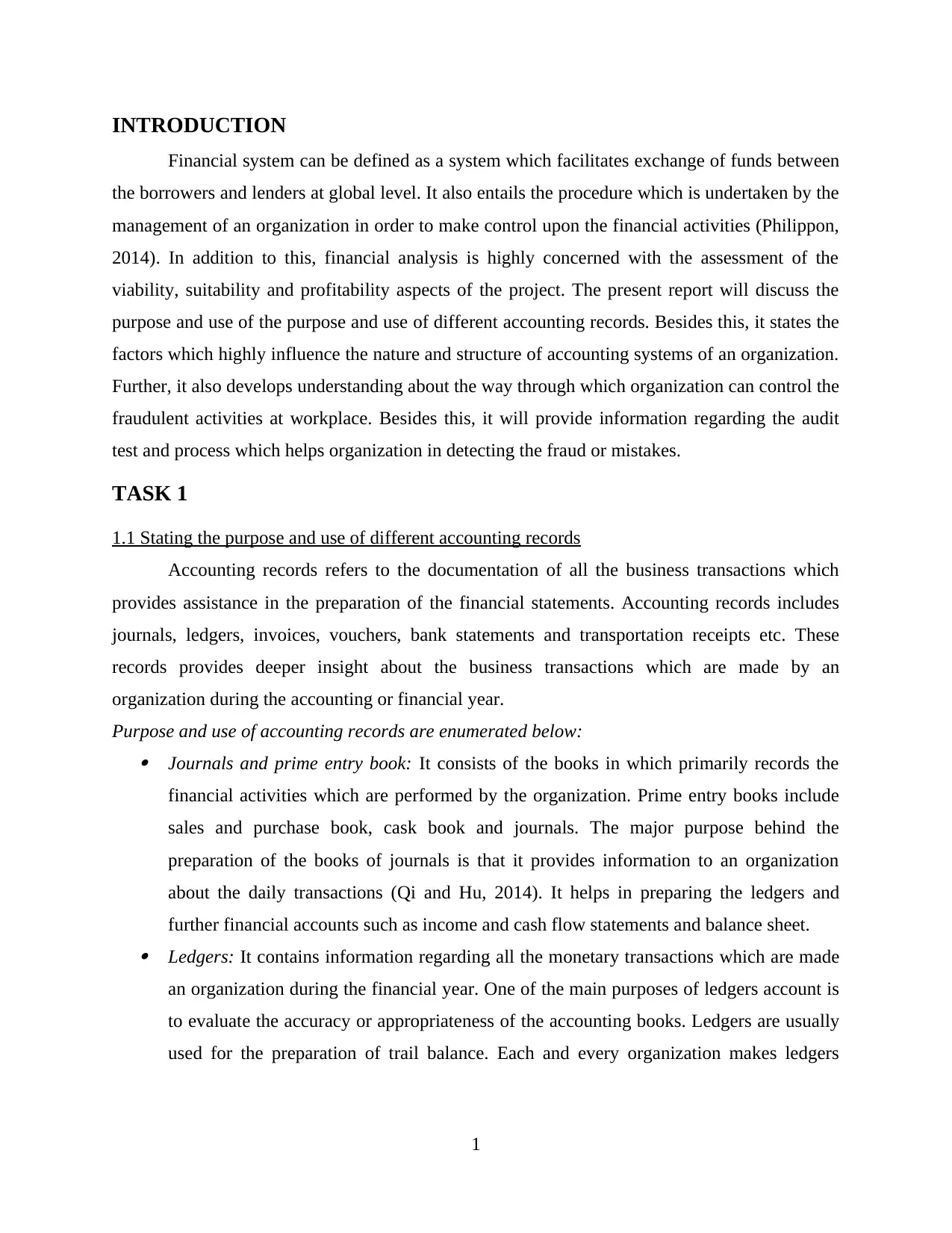
INTRODUCTION
Financial system can be defined as a system which facilitates exchange of funds between
the borrowers and lenders at global level. It also entails the procedure which is undertaken by the
management of an organization in order to make control upon the financial activities (Philippon,
2014). In addition to this, financial analysis is highly concerned with the assessment of the
viability, suitability and profitability aspects of the project. The present report will discuss the
purpose and use of the purpose and use of different accounting records. Besides this, it states the
factors which highly influence the nature and structure of accounting systems of an organization.
Further, it also develops understanding about the way through which organization can control the
fraudulent activities at workplace. Besides this, it will provide information regarding the audit
test and process which helps organization in detecting the fraud or mistakes.
TASK 1
1.1 Stating the purpose and use of different accounting records
Accounting records refers to the documentation of all the business transactions which
provides assistance in the preparation of the financial statements. Accounting records includes
journals, ledgers, invoices, vouchers, bank statements and transportation receipts etc. These
records provides deeper insight about the business transactions which are made by an
organization during the accounting or financial year.
Purpose and use of accounting records are enumerated below: Journals and prime entry book: It consists of the books in which primarily records the
financial activities which are performed by the organization. Prime entry books include
sales and purchase book, cask book and journals. The major purpose behind the
preparation of the books of journals is that it provides information to an organization
about the daily transactions (Qi and Hu, 2014). It helps in preparing the ledgers and
further financial accounts such as income and cash flow statements and balance sheet. Ledgers: It contains information regarding all the monetary transactions which are made
an organization during the financial year. One of the main purposes of ledgers account is
to evaluate the accuracy or appropriateness of the accounting books. Ledgers are usually
used for the preparation of trail balance. Each and every organization makes ledgers
1
Financial system can be defined as a system which facilitates exchange of funds between
the borrowers and lenders at global level. It also entails the procedure which is undertaken by the
management of an organization in order to make control upon the financial activities (Philippon,
2014). In addition to this, financial analysis is highly concerned with the assessment of the
viability, suitability and profitability aspects of the project. The present report will discuss the
purpose and use of the purpose and use of different accounting records. Besides this, it states the
factors which highly influence the nature and structure of accounting systems of an organization.
Further, it also develops understanding about the way through which organization can control the
fraudulent activities at workplace. Besides this, it will provide information regarding the audit
test and process which helps organization in detecting the fraud or mistakes.
TASK 1
1.1 Stating the purpose and use of different accounting records
Accounting records refers to the documentation of all the business transactions which
provides assistance in the preparation of the financial statements. Accounting records includes
journals, ledgers, invoices, vouchers, bank statements and transportation receipts etc. These
records provides deeper insight about the business transactions which are made by an
organization during the accounting or financial year.
Purpose and use of accounting records are enumerated below: Journals and prime entry book: It consists of the books in which primarily records the
financial activities which are performed by the organization. Prime entry books include
sales and purchase book, cask book and journals. The major purpose behind the
preparation of the books of journals is that it provides information to an organization
about the daily transactions (Qi and Hu, 2014). It helps in preparing the ledgers and
further financial accounts such as income and cash flow statements and balance sheet. Ledgers: It contains information regarding all the monetary transactions which are made
an organization during the financial year. One of the main purposes of ledgers account is
to evaluate the accuracy or appropriateness of the accounting books. Ledgers are usually
used for the preparation of trail balance. Each and every organization makes ledgers
1
⊘ This is a preview!⊘
Do you want full access?
Subscribe today to unlock all pages.

Trusted by 1+ million students worldwide
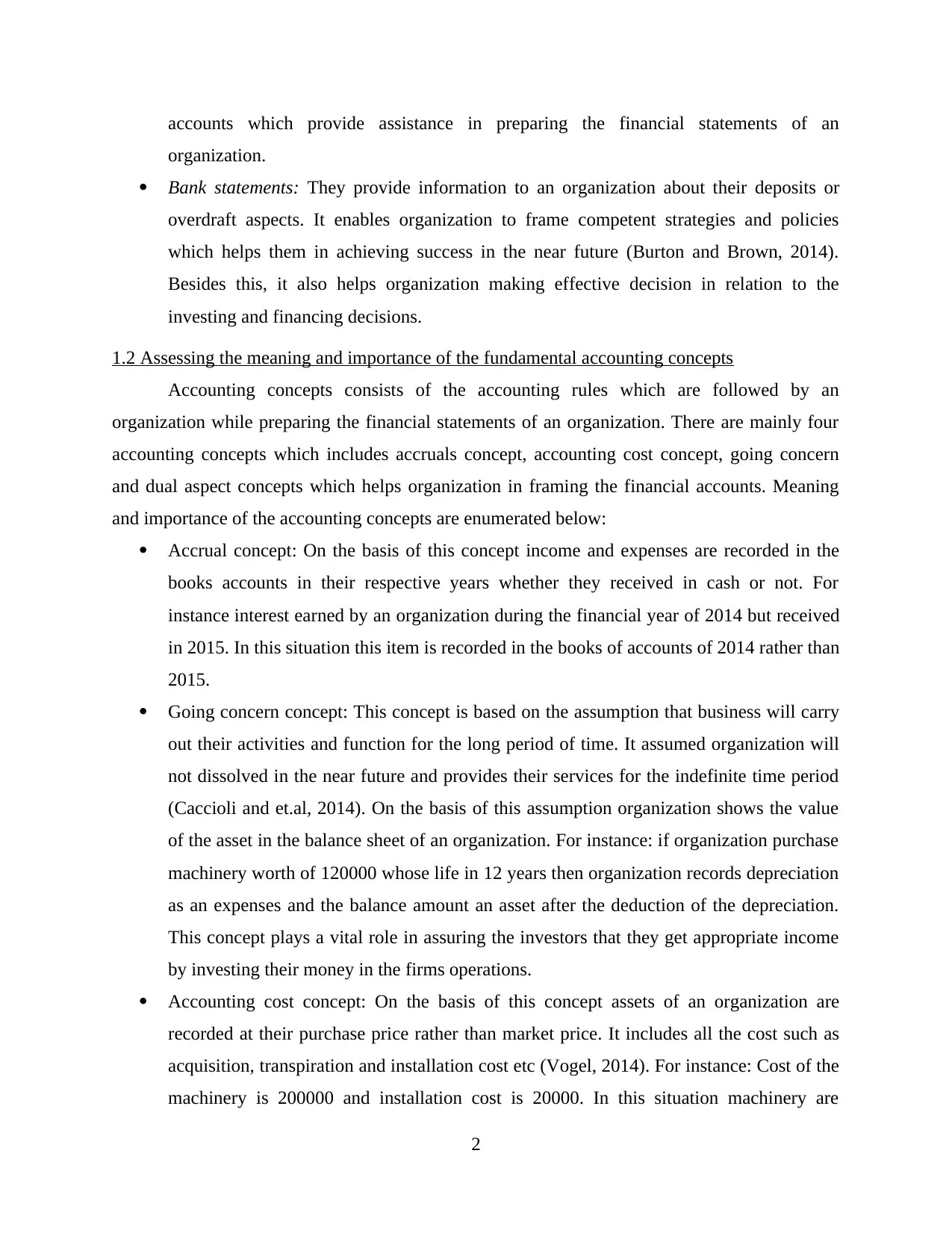
accounts which provide assistance in preparing the financial statements of an
organization.
Bank statements: They provide information to an organization about their deposits or
overdraft aspects. It enables organization to frame competent strategies and policies
which helps them in achieving success in the near future (Burton and Brown, 2014).
Besides this, it also helps organization making effective decision in relation to the
investing and financing decisions.
1.2 Assessing the meaning and importance of the fundamental accounting concepts
Accounting concepts consists of the accounting rules which are followed by an
organization while preparing the financial statements of an organization. There are mainly four
accounting concepts which includes accruals concept, accounting cost concept, going concern
and dual aspect concepts which helps organization in framing the financial accounts. Meaning
and importance of the accounting concepts are enumerated below:
Accrual concept: On the basis of this concept income and expenses are recorded in the
books accounts in their respective years whether they received in cash or not. For
instance interest earned by an organization during the financial year of 2014 but received
in 2015. In this situation this item is recorded in the books of accounts of 2014 rather than
2015.
Going concern concept: This concept is based on the assumption that business will carry
out their activities and function for the long period of time. It assumed organization will
not dissolved in the near future and provides their services for the indefinite time period
(Caccioli and et.al, 2014). On the basis of this assumption organization shows the value
of the asset in the balance sheet of an organization. For instance: if organization purchase
machinery worth of 120000 whose life in 12 years then organization records depreciation
as an expenses and the balance amount an asset after the deduction of the depreciation.
This concept plays a vital role in assuring the investors that they get appropriate income
by investing their money in the firms operations.
Accounting cost concept: On the basis of this concept assets of an organization are
recorded at their purchase price rather than market price. It includes all the cost such as
acquisition, transpiration and installation cost etc (Vogel, 2014). For instance: Cost of the
machinery is 200000 and installation cost is 20000. In this situation machinery are
2
organization.
Bank statements: They provide information to an organization about their deposits or
overdraft aspects. It enables organization to frame competent strategies and policies
which helps them in achieving success in the near future (Burton and Brown, 2014).
Besides this, it also helps organization making effective decision in relation to the
investing and financing decisions.
1.2 Assessing the meaning and importance of the fundamental accounting concepts
Accounting concepts consists of the accounting rules which are followed by an
organization while preparing the financial statements of an organization. There are mainly four
accounting concepts which includes accruals concept, accounting cost concept, going concern
and dual aspect concepts which helps organization in framing the financial accounts. Meaning
and importance of the accounting concepts are enumerated below:
Accrual concept: On the basis of this concept income and expenses are recorded in the
books accounts in their respective years whether they received in cash or not. For
instance interest earned by an organization during the financial year of 2014 but received
in 2015. In this situation this item is recorded in the books of accounts of 2014 rather than
2015.
Going concern concept: This concept is based on the assumption that business will carry
out their activities and function for the long period of time. It assumed organization will
not dissolved in the near future and provides their services for the indefinite time period
(Caccioli and et.al, 2014). On the basis of this assumption organization shows the value
of the asset in the balance sheet of an organization. For instance: if organization purchase
machinery worth of 120000 whose life in 12 years then organization records depreciation
as an expenses and the balance amount an asset after the deduction of the depreciation.
This concept plays a vital role in assuring the investors that they get appropriate income
by investing their money in the firms operations.
Accounting cost concept: On the basis of this concept assets of an organization are
recorded at their purchase price rather than market price. It includes all the cost such as
acquisition, transpiration and installation cost etc (Vogel, 2014). For instance: Cost of the
machinery is 200000 and installation cost is 20000. In this situation machinery are
2
Paraphrase This Document
Need a fresh take? Get an instant paraphrase of this document with our AI Paraphraser
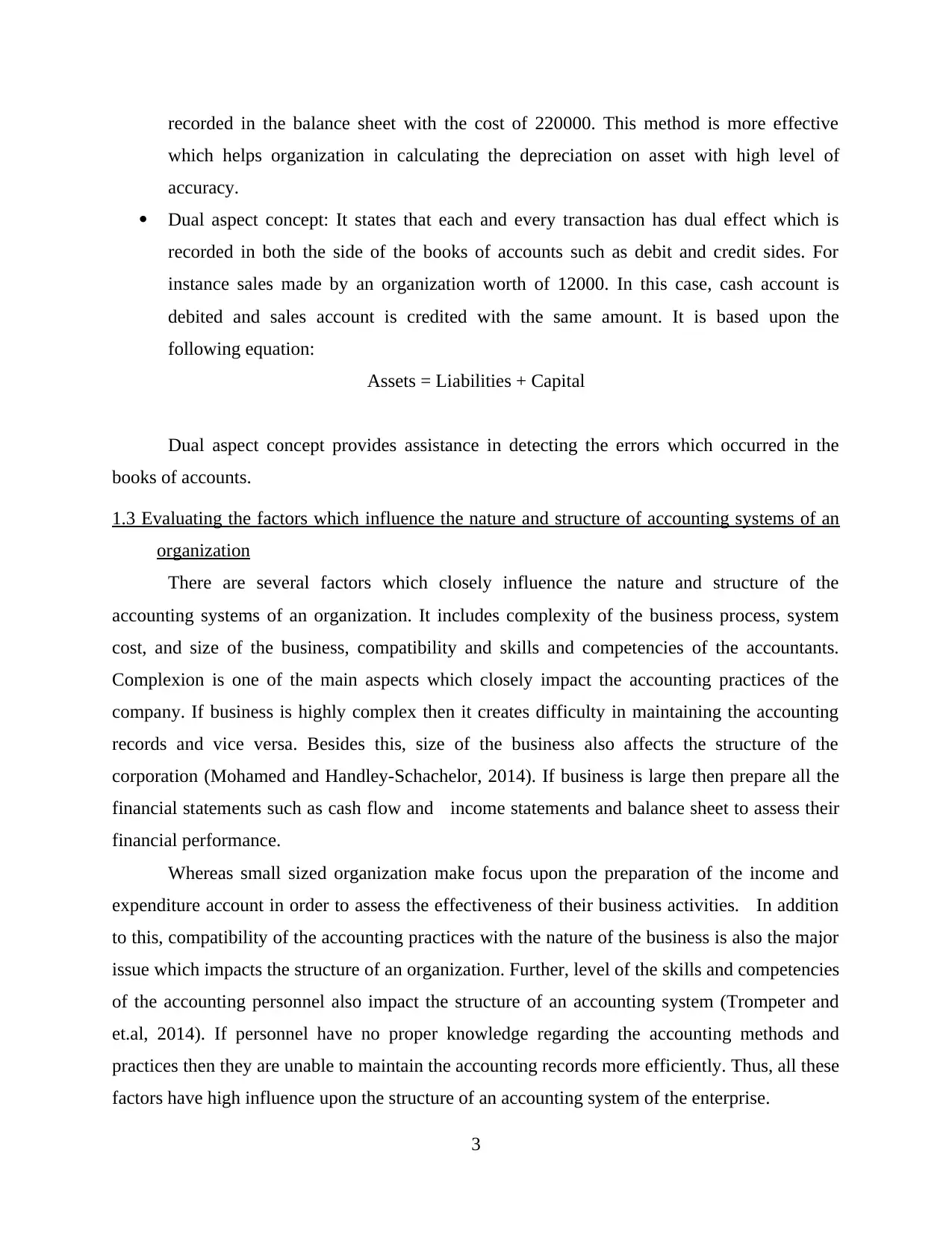
recorded in the balance sheet with the cost of 220000. This method is more effective
which helps organization in calculating the depreciation on asset with high level of
accuracy.
Dual aspect concept: It states that each and every transaction has dual effect which is
recorded in both the side of the books of accounts such as debit and credit sides. For
instance sales made by an organization worth of 12000. In this case, cash account is
debited and sales account is credited with the same amount. It is based upon the
following equation:
Assets = Liabilities + Capital
Dual aspect concept provides assistance in detecting the errors which occurred in the
books of accounts.
1.3 Evaluating the factors which influence the nature and structure of accounting systems of an
organization
There are several factors which closely influence the nature and structure of the
accounting systems of an organization. It includes complexity of the business process, system
cost, and size of the business, compatibility and skills and competencies of the accountants.
Complexion is one of the main aspects which closely impact the accounting practices of the
company. If business is highly complex then it creates difficulty in maintaining the accounting
records and vice versa. Besides this, size of the business also affects the structure of the
corporation (Mohamed and Handley-Schachelor, 2014). If business is large then prepare all the
financial statements such as cash flow and income statements and balance sheet to assess their
financial performance.
Whereas small sized organization make focus upon the preparation of the income and
expenditure account in order to assess the effectiveness of their business activities. In addition
to this, compatibility of the accounting practices with the nature of the business is also the major
issue which impacts the structure of an organization. Further, level of the skills and competencies
of the accounting personnel also impact the structure of an accounting system (Trompeter and
et.al, 2014). If personnel have no proper knowledge regarding the accounting methods and
practices then they are unable to maintain the accounting records more efficiently. Thus, all these
factors have high influence upon the structure of an accounting system of the enterprise.
3
which helps organization in calculating the depreciation on asset with high level of
accuracy.
Dual aspect concept: It states that each and every transaction has dual effect which is
recorded in both the side of the books of accounts such as debit and credit sides. For
instance sales made by an organization worth of 12000. In this case, cash account is
debited and sales account is credited with the same amount. It is based upon the
following equation:
Assets = Liabilities + Capital
Dual aspect concept provides assistance in detecting the errors which occurred in the
books of accounts.
1.3 Evaluating the factors which influence the nature and structure of accounting systems of an
organization
There are several factors which closely influence the nature and structure of the
accounting systems of an organization. It includes complexity of the business process, system
cost, and size of the business, compatibility and skills and competencies of the accountants.
Complexion is one of the main aspects which closely impact the accounting practices of the
company. If business is highly complex then it creates difficulty in maintaining the accounting
records and vice versa. Besides this, size of the business also affects the structure of the
corporation (Mohamed and Handley-Schachelor, 2014). If business is large then prepare all the
financial statements such as cash flow and income statements and balance sheet to assess their
financial performance.
Whereas small sized organization make focus upon the preparation of the income and
expenditure account in order to assess the effectiveness of their business activities. In addition
to this, compatibility of the accounting practices with the nature of the business is also the major
issue which impacts the structure of an organization. Further, level of the skills and competencies
of the accounting personnel also impact the structure of an accounting system (Trompeter and
et.al, 2014). If personnel have no proper knowledge regarding the accounting methods and
practices then they are unable to maintain the accounting records more efficiently. Thus, all these
factors have high influence upon the structure of an accounting system of the enterprise.
3
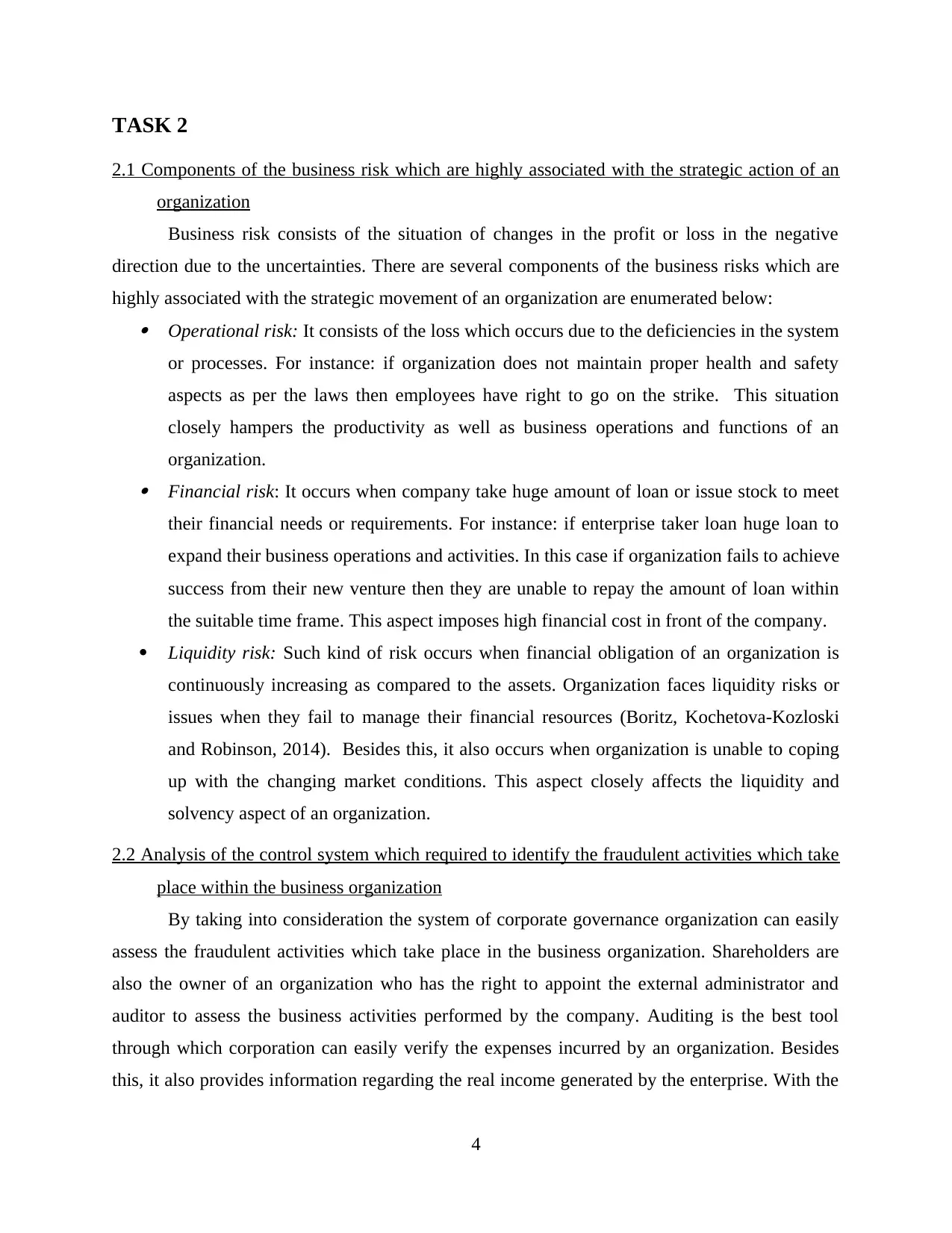
TASK 2
2.1 Components of the business risk which are highly associated with the strategic action of an
organization
Business risk consists of the situation of changes in the profit or loss in the negative
direction due to the uncertainties. There are several components of the business risks which are
highly associated with the strategic movement of an organization are enumerated below: Operational risk: It consists of the loss which occurs due to the deficiencies in the system
or processes. For instance: if organization does not maintain proper health and safety
aspects as per the laws then employees have right to go on the strike. This situation
closely hampers the productivity as well as business operations and functions of an
organization. Financial risk: It occurs when company take huge amount of loan or issue stock to meet
their financial needs or requirements. For instance: if enterprise taker loan huge loan to
expand their business operations and activities. In this case if organization fails to achieve
success from their new venture then they are unable to repay the amount of loan within
the suitable time frame. This aspect imposes high financial cost in front of the company.
Liquidity risk: Such kind of risk occurs when financial obligation of an organization is
continuously increasing as compared to the assets. Organization faces liquidity risks or
issues when they fail to manage their financial resources (Boritz, Kochetova-Kozloski
and Robinson, 2014). Besides this, it also occurs when organization is unable to coping
up with the changing market conditions. This aspect closely affects the liquidity and
solvency aspect of an organization.
2.2 Analysis of the control system which required to identify the fraudulent activities which take
place within the business organization
By taking into consideration the system of corporate governance organization can easily
assess the fraudulent activities which take place in the business organization. Shareholders are
also the owner of an organization who has the right to appoint the external administrator and
auditor to assess the business activities performed by the company. Auditing is the best tool
through which corporation can easily verify the expenses incurred by an organization. Besides
this, it also provides information regarding the real income generated by the enterprise. With the
4
2.1 Components of the business risk which are highly associated with the strategic action of an
organization
Business risk consists of the situation of changes in the profit or loss in the negative
direction due to the uncertainties. There are several components of the business risks which are
highly associated with the strategic movement of an organization are enumerated below: Operational risk: It consists of the loss which occurs due to the deficiencies in the system
or processes. For instance: if organization does not maintain proper health and safety
aspects as per the laws then employees have right to go on the strike. This situation
closely hampers the productivity as well as business operations and functions of an
organization. Financial risk: It occurs when company take huge amount of loan or issue stock to meet
their financial needs or requirements. For instance: if enterprise taker loan huge loan to
expand their business operations and activities. In this case if organization fails to achieve
success from their new venture then they are unable to repay the amount of loan within
the suitable time frame. This aspect imposes high financial cost in front of the company.
Liquidity risk: Such kind of risk occurs when financial obligation of an organization is
continuously increasing as compared to the assets. Organization faces liquidity risks or
issues when they fail to manage their financial resources (Boritz, Kochetova-Kozloski
and Robinson, 2014). Besides this, it also occurs when organization is unable to coping
up with the changing market conditions. This aspect closely affects the liquidity and
solvency aspect of an organization.
2.2 Analysis of the control system which required to identify the fraudulent activities which take
place within the business organization
By taking into consideration the system of corporate governance organization can easily
assess the fraudulent activities which take place in the business organization. Shareholders are
also the owner of an organization who has the right to appoint the external administrator and
auditor to assess the business activities performed by the company. Auditing is the best tool
through which corporation can easily verify the expenses incurred by an organization. Besides
this, it also provides information regarding the real income generated by the enterprise. With the
4
⊘ This is a preview!⊘
Do you want full access?
Subscribe today to unlock all pages.

Trusted by 1+ million students worldwide
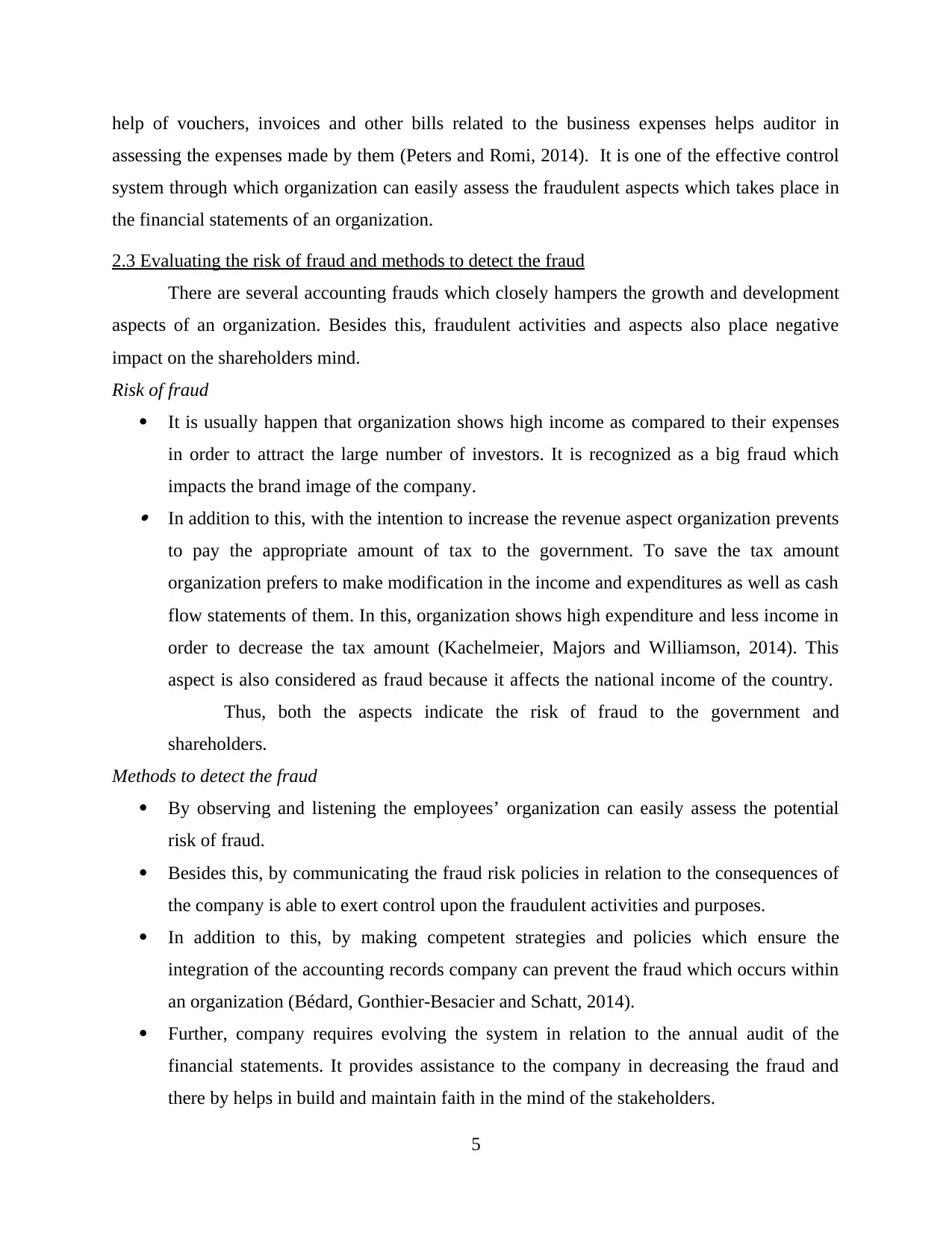
help of vouchers, invoices and other bills related to the business expenses helps auditor in
assessing the expenses made by them (Peters and Romi, 2014). It is one of the effective control
system through which organization can easily assess the fraudulent aspects which takes place in
the financial statements of an organization.
2.3 Evaluating the risk of fraud and methods to detect the fraud
There are several accounting frauds which closely hampers the growth and development
aspects of an organization. Besides this, fraudulent activities and aspects also place negative
impact on the shareholders mind.
Risk of fraud
It is usually happen that organization shows high income as compared to their expenses
in order to attract the large number of investors. It is recognized as a big fraud which
impacts the brand image of the company. In addition to this, with the intention to increase the revenue aspect organization prevents
to pay the appropriate amount of tax to the government. To save the tax amount
organization prefers to make modification in the income and expenditures as well as cash
flow statements of them. In this, organization shows high expenditure and less income in
order to decrease the tax amount (Kachelmeier, Majors and Williamson, 2014). This
aspect is also considered as fraud because it affects the national income of the country.
Thus, both the aspects indicate the risk of fraud to the government and
shareholders.
Methods to detect the fraud
By observing and listening the employees’ organization can easily assess the potential
risk of fraud.
Besides this, by communicating the fraud risk policies in relation to the consequences of
the company is able to exert control upon the fraudulent activities and purposes.
In addition to this, by making competent strategies and policies which ensure the
integration of the accounting records company can prevent the fraud which occurs within
an organization (Bédard, Gonthier-Besacier and Schatt, 2014).
Further, company requires evolving the system in relation to the annual audit of the
financial statements. It provides assistance to the company in decreasing the fraud and
there by helps in build and maintain faith in the mind of the stakeholders.
5
assessing the expenses made by them (Peters and Romi, 2014). It is one of the effective control
system through which organization can easily assess the fraudulent aspects which takes place in
the financial statements of an organization.
2.3 Evaluating the risk of fraud and methods to detect the fraud
There are several accounting frauds which closely hampers the growth and development
aspects of an organization. Besides this, fraudulent activities and aspects also place negative
impact on the shareholders mind.
Risk of fraud
It is usually happen that organization shows high income as compared to their expenses
in order to attract the large number of investors. It is recognized as a big fraud which
impacts the brand image of the company. In addition to this, with the intention to increase the revenue aspect organization prevents
to pay the appropriate amount of tax to the government. To save the tax amount
organization prefers to make modification in the income and expenditures as well as cash
flow statements of them. In this, organization shows high expenditure and less income in
order to decrease the tax amount (Kachelmeier, Majors and Williamson, 2014). This
aspect is also considered as fraud because it affects the national income of the country.
Thus, both the aspects indicate the risk of fraud to the government and
shareholders.
Methods to detect the fraud
By observing and listening the employees’ organization can easily assess the potential
risk of fraud.
Besides this, by communicating the fraud risk policies in relation to the consequences of
the company is able to exert control upon the fraudulent activities and purposes.
In addition to this, by making competent strategies and policies which ensure the
integration of the accounting records company can prevent the fraud which occurs within
an organization (Bédard, Gonthier-Besacier and Schatt, 2014).
Further, company requires evolving the system in relation to the annual audit of the
financial statements. It provides assistance to the company in decreasing the fraud and
there by helps in build and maintain faith in the mind of the stakeholders.
5
Paraphrase This Document
Need a fresh take? Get an instant paraphrase of this document with our AI Paraphraser
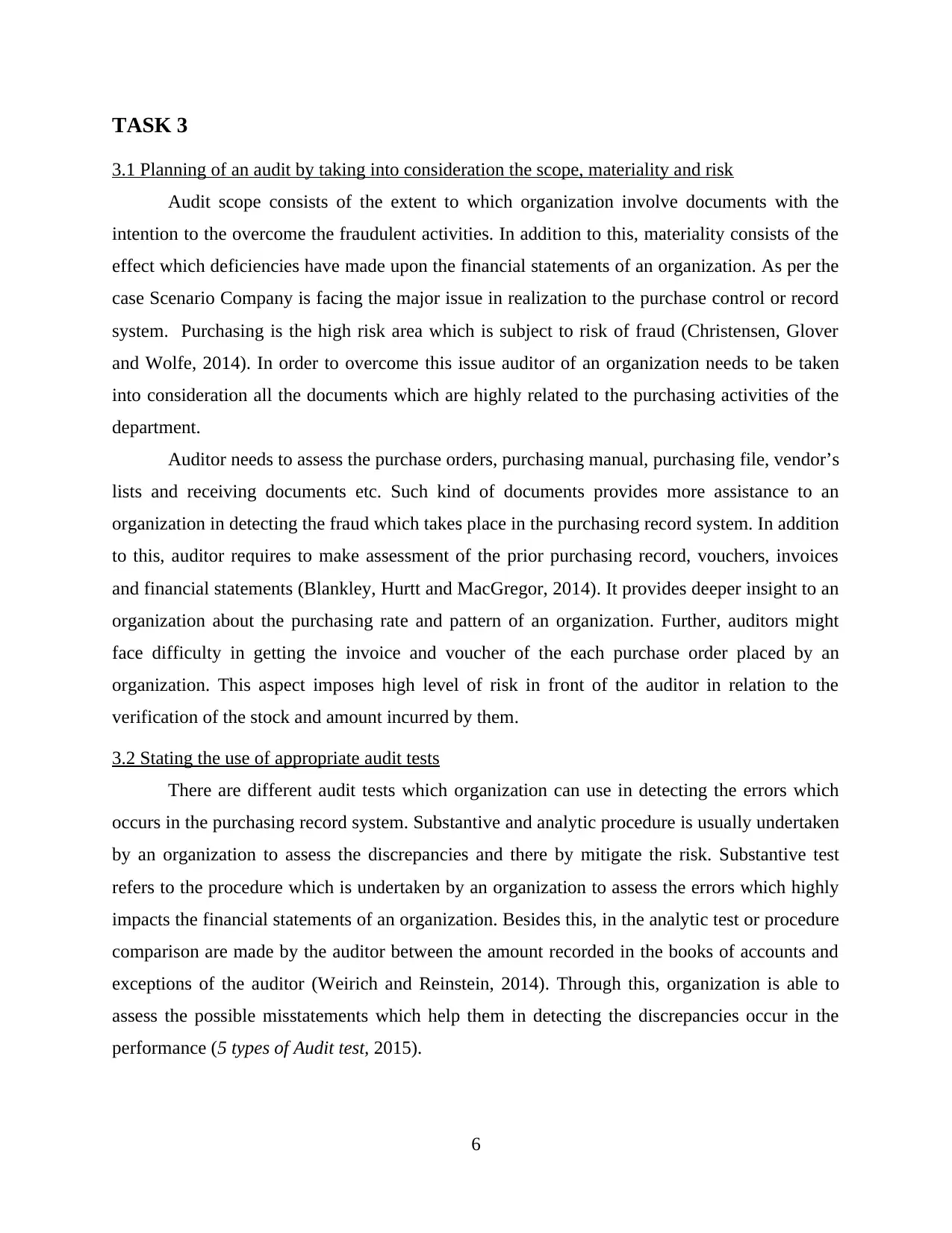
TASK 3
3.1 Planning of an audit by taking into consideration the scope, materiality and risk
Audit scope consists of the extent to which organization involve documents with the
intention to the overcome the fraudulent activities. In addition to this, materiality consists of the
effect which deficiencies have made upon the financial statements of an organization. As per the
case Scenario Company is facing the major issue in realization to the purchase control or record
system. Purchasing is the high risk area which is subject to risk of fraud (Christensen, Glover
and Wolfe, 2014). In order to overcome this issue auditor of an organization needs to be taken
into consideration all the documents which are highly related to the purchasing activities of the
department.
Auditor needs to assess the purchase orders, purchasing manual, purchasing file, vendor’s
lists and receiving documents etc. Such kind of documents provides more assistance to an
organization in detecting the fraud which takes place in the purchasing record system. In addition
to this, auditor requires to make assessment of the prior purchasing record, vouchers, invoices
and financial statements (Blankley, Hurtt and MacGregor, 2014). It provides deeper insight to an
organization about the purchasing rate and pattern of an organization. Further, auditors might
face difficulty in getting the invoice and voucher of the each purchase order placed by an
organization. This aspect imposes high level of risk in front of the auditor in relation to the
verification of the stock and amount incurred by them.
3.2 Stating the use of appropriate audit tests
There are different audit tests which organization can use in detecting the errors which
occurs in the purchasing record system. Substantive and analytic procedure is usually undertaken
by an organization to assess the discrepancies and there by mitigate the risk. Substantive test
refers to the procedure which is undertaken by an organization to assess the errors which highly
impacts the financial statements of an organization. Besides this, in the analytic test or procedure
comparison are made by the auditor between the amount recorded in the books of accounts and
exceptions of the auditor (Weirich and Reinstein, 2014). Through this, organization is able to
assess the possible misstatements which help them in detecting the discrepancies occur in the
performance (5 types of Audit test, 2015).
6
3.1 Planning of an audit by taking into consideration the scope, materiality and risk
Audit scope consists of the extent to which organization involve documents with the
intention to the overcome the fraudulent activities. In addition to this, materiality consists of the
effect which deficiencies have made upon the financial statements of an organization. As per the
case Scenario Company is facing the major issue in realization to the purchase control or record
system. Purchasing is the high risk area which is subject to risk of fraud (Christensen, Glover
and Wolfe, 2014). In order to overcome this issue auditor of an organization needs to be taken
into consideration all the documents which are highly related to the purchasing activities of the
department.
Auditor needs to assess the purchase orders, purchasing manual, purchasing file, vendor’s
lists and receiving documents etc. Such kind of documents provides more assistance to an
organization in detecting the fraud which takes place in the purchasing record system. In addition
to this, auditor requires to make assessment of the prior purchasing record, vouchers, invoices
and financial statements (Blankley, Hurtt and MacGregor, 2014). It provides deeper insight to an
organization about the purchasing rate and pattern of an organization. Further, auditors might
face difficulty in getting the invoice and voucher of the each purchase order placed by an
organization. This aspect imposes high level of risk in front of the auditor in relation to the
verification of the stock and amount incurred by them.
3.2 Stating the use of appropriate audit tests
There are different audit tests which organization can use in detecting the errors which
occurs in the purchasing record system. Substantive and analytic procedure is usually undertaken
by an organization to assess the discrepancies and there by mitigate the risk. Substantive test
refers to the procedure which is undertaken by an organization to assess the errors which highly
impacts the financial statements of an organization. Besides this, in the analytic test or procedure
comparison are made by the auditor between the amount recorded in the books of accounts and
exceptions of the auditor (Weirich and Reinstein, 2014). Through this, organization is able to
assess the possible misstatements which help them in detecting the discrepancies occur in the
performance (5 types of Audit test, 2015).
6
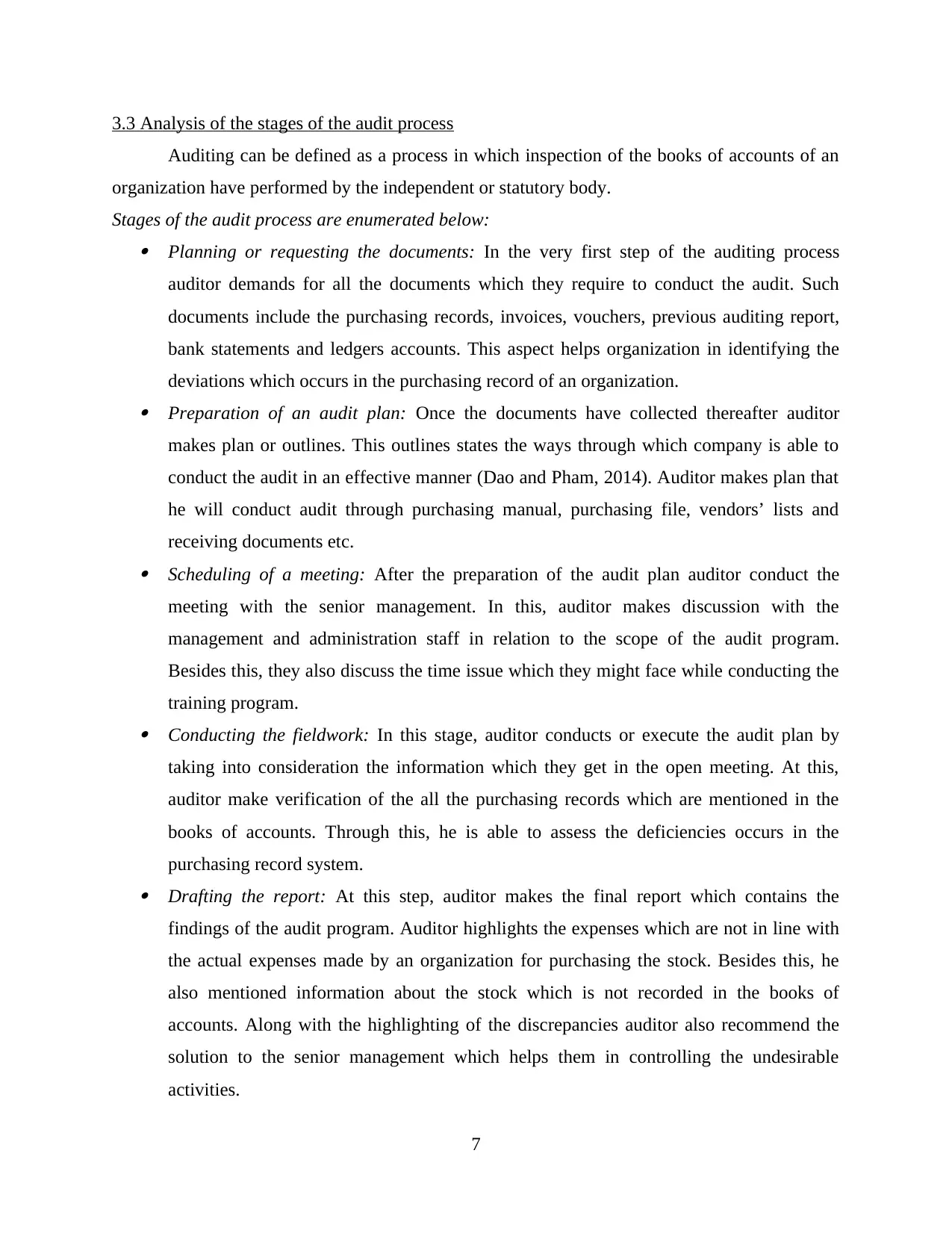
3.3 Analysis of the stages of the audit process
Auditing can be defined as a process in which inspection of the books of accounts of an
organization have performed by the independent or statutory body.
Stages of the audit process are enumerated below: Planning or requesting the documents: In the very first step of the auditing process
auditor demands for all the documents which they require to conduct the audit. Such
documents include the purchasing records, invoices, vouchers, previous auditing report,
bank statements and ledgers accounts. This aspect helps organization in identifying the
deviations which occurs in the purchasing record of an organization. Preparation of an audit plan: Once the documents have collected thereafter auditor
makes plan or outlines. This outlines states the ways through which company is able to
conduct the audit in an effective manner (Dao and Pham, 2014). Auditor makes plan that
he will conduct audit through purchasing manual, purchasing file, vendors’ lists and
receiving documents etc. Scheduling of a meeting: After the preparation of the audit plan auditor conduct the
meeting with the senior management. In this, auditor makes discussion with the
management and administration staff in relation to the scope of the audit program.
Besides this, they also discuss the time issue which they might face while conducting the
training program. Conducting the fieldwork: In this stage, auditor conducts or execute the audit plan by
taking into consideration the information which they get in the open meeting. At this,
auditor make verification of the all the purchasing records which are mentioned in the
books of accounts. Through this, he is able to assess the deficiencies occurs in the
purchasing record system. Drafting the report: At this step, auditor makes the final report which contains the
findings of the audit program. Auditor highlights the expenses which are not in line with
the actual expenses made by an organization for purchasing the stock. Besides this, he
also mentioned information about the stock which is not recorded in the books of
accounts. Along with the highlighting of the discrepancies auditor also recommend the
solution to the senior management which helps them in controlling the undesirable
activities.
7
Auditing can be defined as a process in which inspection of the books of accounts of an
organization have performed by the independent or statutory body.
Stages of the audit process are enumerated below: Planning or requesting the documents: In the very first step of the auditing process
auditor demands for all the documents which they require to conduct the audit. Such
documents include the purchasing records, invoices, vouchers, previous auditing report,
bank statements and ledgers accounts. This aspect helps organization in identifying the
deviations which occurs in the purchasing record of an organization. Preparation of an audit plan: Once the documents have collected thereafter auditor
makes plan or outlines. This outlines states the ways through which company is able to
conduct the audit in an effective manner (Dao and Pham, 2014). Auditor makes plan that
he will conduct audit through purchasing manual, purchasing file, vendors’ lists and
receiving documents etc. Scheduling of a meeting: After the preparation of the audit plan auditor conduct the
meeting with the senior management. In this, auditor makes discussion with the
management and administration staff in relation to the scope of the audit program.
Besides this, they also discuss the time issue which they might face while conducting the
training program. Conducting the fieldwork: In this stage, auditor conducts or execute the audit plan by
taking into consideration the information which they get in the open meeting. At this,
auditor make verification of the all the purchasing records which are mentioned in the
books of accounts. Through this, he is able to assess the deficiencies occurs in the
purchasing record system. Drafting the report: At this step, auditor makes the final report which contains the
findings of the audit program. Auditor highlights the expenses which are not in line with
the actual expenses made by an organization for purchasing the stock. Besides this, he
also mentioned information about the stock which is not recorded in the books of
accounts. Along with the highlighting of the discrepancies auditor also recommend the
solution to the senior management which helps them in controlling the undesirable
activities.
7
⊘ This is a preview!⊘
Do you want full access?
Subscribe today to unlock all pages.

Trusted by 1+ million students worldwide
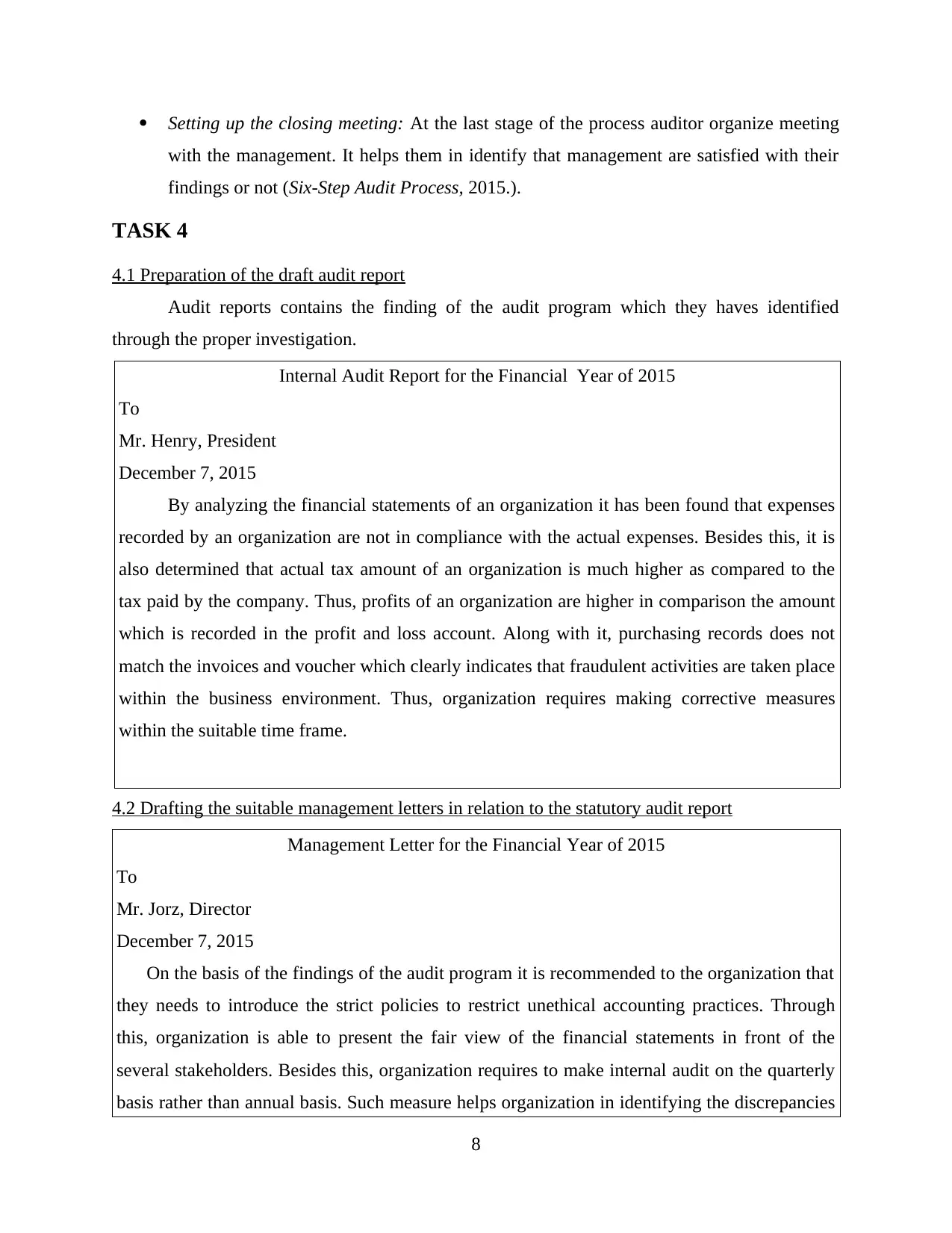
Setting up the closing meeting: At the last stage of the process auditor organize meeting
with the management. It helps them in identify that management are satisfied with their
findings or not (Six-Step Audit Process, 2015.).
TASK 4
4.1 Preparation of the draft audit report
Audit reports contains the finding of the audit program which they haves identified
through the proper investigation.
Internal Audit Report for the Financial Year of 2015
To
Mr. Henry, President
December 7, 2015
By analyzing the financial statements of an organization it has been found that expenses
recorded by an organization are not in compliance with the actual expenses. Besides this, it is
also determined that actual tax amount of an organization is much higher as compared to the
tax paid by the company. Thus, profits of an organization are higher in comparison the amount
which is recorded in the profit and loss account. Along with it, purchasing records does not
match the invoices and voucher which clearly indicates that fraudulent activities are taken place
within the business environment. Thus, organization requires making corrective measures
within the suitable time frame.
4.2 Drafting the suitable management letters in relation to the statutory audit report
Management Letter for the Financial Year of 2015
To
Mr. Jorz, Director
December 7, 2015
On the basis of the findings of the audit program it is recommended to the organization that
they needs to introduce the strict policies to restrict unethical accounting practices. Through
this, organization is able to present the fair view of the financial statements in front of the
several stakeholders. Besides this, organization requires to make internal audit on the quarterly
basis rather than annual basis. Such measure helps organization in identifying the discrepancies
8
with the management. It helps them in identify that management are satisfied with their
findings or not (Six-Step Audit Process, 2015.).
TASK 4
4.1 Preparation of the draft audit report
Audit reports contains the finding of the audit program which they haves identified
through the proper investigation.
Internal Audit Report for the Financial Year of 2015
To
Mr. Henry, President
December 7, 2015
By analyzing the financial statements of an organization it has been found that expenses
recorded by an organization are not in compliance with the actual expenses. Besides this, it is
also determined that actual tax amount of an organization is much higher as compared to the
tax paid by the company. Thus, profits of an organization are higher in comparison the amount
which is recorded in the profit and loss account. Along with it, purchasing records does not
match the invoices and voucher which clearly indicates that fraudulent activities are taken place
within the business environment. Thus, organization requires making corrective measures
within the suitable time frame.
4.2 Drafting the suitable management letters in relation to the statutory audit report
Management Letter for the Financial Year of 2015
To
Mr. Jorz, Director
December 7, 2015
On the basis of the findings of the audit program it is recommended to the organization that
they needs to introduce the strict policies to restrict unethical accounting practices. Through
this, organization is able to present the fair view of the financial statements in front of the
several stakeholders. Besides this, organization requires to make internal audit on the quarterly
basis rather than annual basis. Such measure helps organization in identifying the discrepancies
8
Paraphrase This Document
Need a fresh take? Get an instant paraphrase of this document with our AI Paraphraser
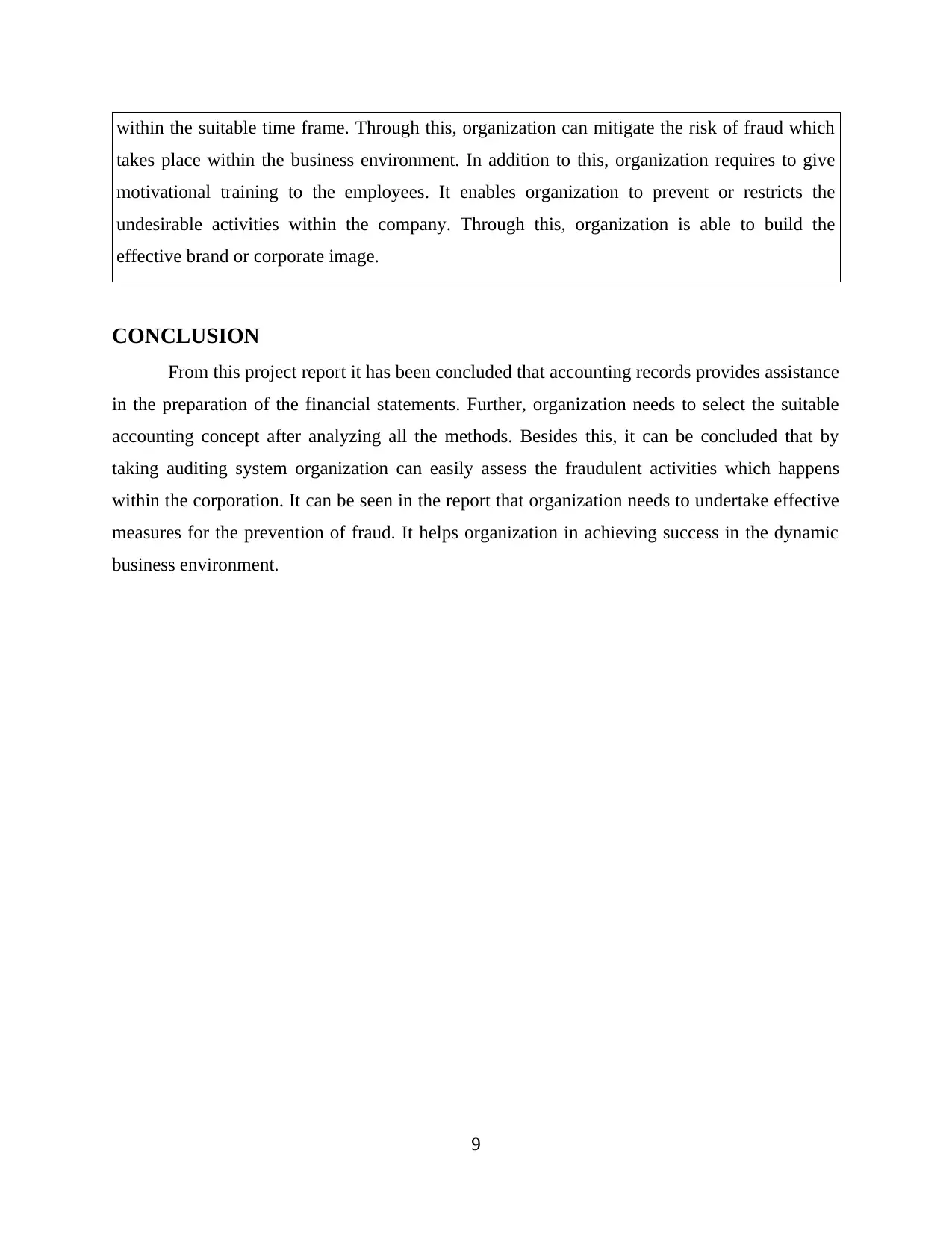
within the suitable time frame. Through this, organization can mitigate the risk of fraud which
takes place within the business environment. In addition to this, organization requires to give
motivational training to the employees. It enables organization to prevent or restricts the
undesirable activities within the company. Through this, organization is able to build the
effective brand or corporate image.
CONCLUSION
From this project report it has been concluded that accounting records provides assistance
in the preparation of the financial statements. Further, organization needs to select the suitable
accounting concept after analyzing all the methods. Besides this, it can be concluded that by
taking auditing system organization can easily assess the fraudulent activities which happens
within the corporation. It can be seen in the report that organization needs to undertake effective
measures for the prevention of fraud. It helps organization in achieving success in the dynamic
business environment.
9
takes place within the business environment. In addition to this, organization requires to give
motivational training to the employees. It enables organization to prevent or restricts the
undesirable activities within the company. Through this, organization is able to build the
effective brand or corporate image.
CONCLUSION
From this project report it has been concluded that accounting records provides assistance
in the preparation of the financial statements. Further, organization needs to select the suitable
accounting concept after analyzing all the methods. Besides this, it can be concluded that by
taking auditing system organization can easily assess the fraudulent activities which happens
within the corporation. It can be seen in the report that organization needs to undertake effective
measures for the prevention of fraud. It helps organization in achieving success in the dynamic
business environment.
9
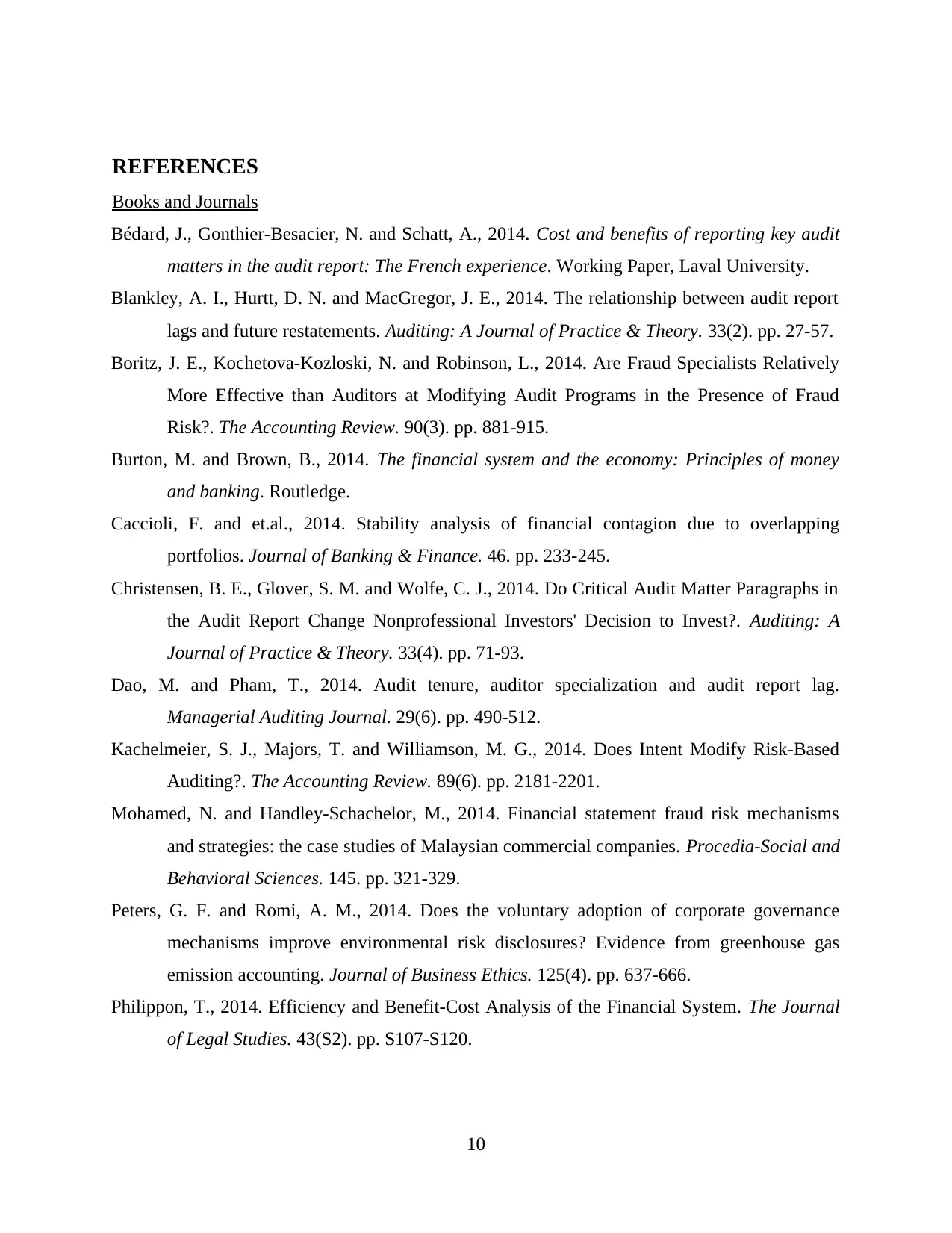
REFERENCES
Books and Journals
Bédard, J., Gonthier-Besacier, N. and Schatt, A., 2014. Cost and benefits of reporting key audit
matters in the audit report: The French experience. Working Paper, Laval University.
Blankley, A. I., Hurtt, D. N. and MacGregor, J. E., 2014. The relationship between audit report
lags and future restatements. Auditing: A Journal of Practice & Theory. 33(2). pp. 27-57.
Boritz, J. E., Kochetova-Kozloski, N. and Robinson, L., 2014. Are Fraud Specialists Relatively
More Effective than Auditors at Modifying Audit Programs in the Presence of Fraud
Risk?. The Accounting Review. 90(3). pp. 881-915.
Burton, M. and Brown, B., 2014. The financial system and the economy: Principles of money
and banking. Routledge.
Caccioli, F. and et.al., 2014. Stability analysis of financial contagion due to overlapping
portfolios. Journal of Banking & Finance. 46. pp. 233-245.
Christensen, B. E., Glover, S. M. and Wolfe, C. J., 2014. Do Critical Audit Matter Paragraphs in
the Audit Report Change Nonprofessional Investors' Decision to Invest?. Auditing: A
Journal of Practice & Theory. 33(4). pp. 71-93.
Dao, M. and Pham, T., 2014. Audit tenure, auditor specialization and audit report lag.
Managerial Auditing Journal. 29(6). pp. 490-512.
Kachelmeier, S. J., Majors, T. and Williamson, M. G., 2014. Does Intent Modify Risk-Based
Auditing?. The Accounting Review. 89(6). pp. 2181-2201.
Mohamed, N. and Handley-Schachelor, M., 2014. Financial statement fraud risk mechanisms
and strategies: the case studies of Malaysian commercial companies. Procedia-Social and
Behavioral Sciences. 145. pp. 321-329.
Peters, G. F. and Romi, A. M., 2014. Does the voluntary adoption of corporate governance
mechanisms improve environmental risk disclosures? Evidence from greenhouse gas
emission accounting. Journal of Business Ethics. 125(4). pp. 637-666.
Philippon, T., 2014. Efficiency and Benefit-Cost Analysis of the Financial System. The Journal
of Legal Studies. 43(S2). pp. S107-S120.
10
Books and Journals
Bédard, J., Gonthier-Besacier, N. and Schatt, A., 2014. Cost and benefits of reporting key audit
matters in the audit report: The French experience. Working Paper, Laval University.
Blankley, A. I., Hurtt, D. N. and MacGregor, J. E., 2014. The relationship between audit report
lags and future restatements. Auditing: A Journal of Practice & Theory. 33(2). pp. 27-57.
Boritz, J. E., Kochetova-Kozloski, N. and Robinson, L., 2014. Are Fraud Specialists Relatively
More Effective than Auditors at Modifying Audit Programs in the Presence of Fraud
Risk?. The Accounting Review. 90(3). pp. 881-915.
Burton, M. and Brown, B., 2014. The financial system and the economy: Principles of money
and banking. Routledge.
Caccioli, F. and et.al., 2014. Stability analysis of financial contagion due to overlapping
portfolios. Journal of Banking & Finance. 46. pp. 233-245.
Christensen, B. E., Glover, S. M. and Wolfe, C. J., 2014. Do Critical Audit Matter Paragraphs in
the Audit Report Change Nonprofessional Investors' Decision to Invest?. Auditing: A
Journal of Practice & Theory. 33(4). pp. 71-93.
Dao, M. and Pham, T., 2014. Audit tenure, auditor specialization and audit report lag.
Managerial Auditing Journal. 29(6). pp. 490-512.
Kachelmeier, S. J., Majors, T. and Williamson, M. G., 2014. Does Intent Modify Risk-Based
Auditing?. The Accounting Review. 89(6). pp. 2181-2201.
Mohamed, N. and Handley-Schachelor, M., 2014. Financial statement fraud risk mechanisms
and strategies: the case studies of Malaysian commercial companies. Procedia-Social and
Behavioral Sciences. 145. pp. 321-329.
Peters, G. F. and Romi, A. M., 2014. Does the voluntary adoption of corporate governance
mechanisms improve environmental risk disclosures? Evidence from greenhouse gas
emission accounting. Journal of Business Ethics. 125(4). pp. 637-666.
Philippon, T., 2014. Efficiency and Benefit-Cost Analysis of the Financial System. The Journal
of Legal Studies. 43(S2). pp. S107-S120.
10
⊘ This is a preview!⊘
Do you want full access?
Subscribe today to unlock all pages.

Trusted by 1+ million students worldwide
1 out of 13
Related Documents
Your All-in-One AI-Powered Toolkit for Academic Success.
+13062052269
info@desklib.com
Available 24*7 on WhatsApp / Email
![[object Object]](/_next/static/media/star-bottom.7253800d.svg)
Unlock your academic potential
Copyright © 2020–2025 A2Z Services. All Rights Reserved. Developed and managed by ZUCOL.





